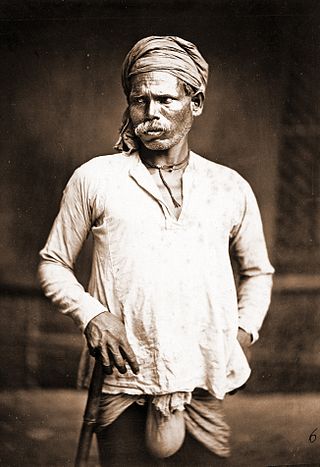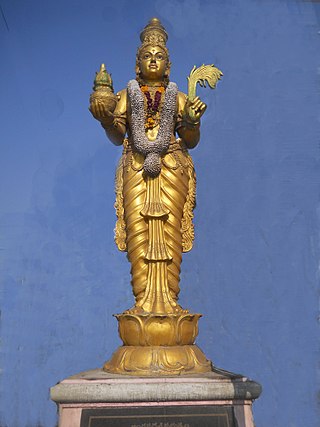
Telugu is a Dravidian language native to the Indian states of Andhra Pradesh and Telangana, where it is also the official language. Spoken by about 96 million people (2022), Telugu is the most widely spoken member of the Dravidian language family, and one of the twenty-two scheduled languages of the Republic of India. It is one of the few languages that has primary official status in more than one Indian state, alongside Hindi and Bengali. Telugu is one of the six languages designated as a classical language by the Government of India. It is the 14th most spoken native language in the world. Modern Standard Telugu is based on the dialect of erstwhile Krishna, Guntur, East and West Godavari districts of Coastal Andhra.

Languages spoken in the Republic of India belong to several language families, the major ones being the Indo-Aryan languages spoken by 78.05% of Indians and the Dravidian languages spoken by 19.64% of Indians; both families together are sometimes known as Indic languages. Languages spoken by the remaining 2.31% of the population belong to the Austroasiatic, Sino–Tibetan, Tai–Kadai, and a few other minor language families and isolates. According to the People's Linguistic Survey of India, India has the second highest number of languages (780), after Papua New Guinea (840). Ethnologue lists a lower number of 456.

The Gondi (Gōṇḍī) or Gond people, who refer to themselves as "Koitur", are an ethnolinguistic group in India. Their native language, Gondi, belongs to the Dravidian family. They are spread over the states of Madhya Pradesh, Maharashtra, Chhattisgarh, Uttar Pradesh, Telangana, Andhra Pradesh, Bihar, and Odisha. They are listed as a Scheduled Tribe for the purpose of India's system of reservation.

The Adivasi refers to heterogeneous tribal groups across the Indian subcontinent. The term is a Sanskrit word coined in the 1930s by political activists to give the tribal people an indigenous identity by claiming an indigenous origin. The term is also used for ethnic minorities, such as Chakmas of Bangladesh, Bhumiputara Khasas of Nepal, and Vedda of Sri Lanka. The Constitution of India does not use the word Adivasi, instead referring to Scheduled Tribes and Janjati. The government of India does not officially recognise tribes as indigenous people. The country ratified the International Labour Organization (ILO) Convention 107 on Indigenous and Tribal Peoples of the United Nations (1957) and refused to sign the ILO Convention 169. Most of these groups are included in the Scheduled Tribe category under constitutional provisions in India.

Bhil or Bheel is an ethnic group in western India. They speak the Bhil languages, a subgroup of the Western Zone of the Indo-Aryan languages. Bhils are members of a tribal group outside the fold of Hinduism and the caste system

Koraput district is a district of India in southern Odisha, with headquarters at Koraput. The district is located in the Eastern Ghats and is known for its hilly terrain, rich and diverse types of mineral deposits and its tribal culture and traditions. The district headquarters town of Koraput and its largest city, Jeypore are major centres of trade and commerce for South Odisha and fall on an important road connecting Visakhapatnam to Raipur.

The Dom, also known as Domra, Domba, Domaka, Dombara and Dombari, are castes, or groups, scattered across India. Dom were a caste of drummer. According to Tantra scriptures, the Dom were engaged in the occupations of singing and playing music. Historically, they were considered an untouchable caste called the Dalits and their traditional occupation was the disposal and cremation of dead bodies. They are in the list of Scheduled caste for Reservation in India in the Indian states of Uttar Pradesh, Bihar, Odisha, Andhra Pradesh, Jharkhand and West Bengal.
The Gutob or Bodo Gadaba language is a south Munda language of the Austroasiatic language family of India, with the greatest concentrations of speakers being found in Koraput district of Odisha and Visakhapatnam district of Andhra Pradesh. It is also known simply as the Gadaba language, but it is different from the Dravidian Gadaba language. Other names for the Bodo Gadaba language include Gadba, Gutop, Gudwa, Godwa, Gadwa, and Boi Gadaba.

Telugu people, also called Telugus, are an ethno-linguistic group who speak the Telugu language and are native to the Indian states of Andhra Pradesh, Telangana and Yanam district of Puducherry. They are the most populous of the four major Dravidian groups. Telugu is the fourth most spoken language in India and the 14th most spoken native language in the world. A significant number of Telugus also reside in the Indian states of Karnataka, Tamil Nadu, Orissa, Maharashtra. Members of the Telugu diaspora are spread across countries like United States, Australia, Malaysia, Mauritius, UAE, and others. Telugu is the fastest-growing language in the United States. It is also a protected language in South Africa.

Khonds are an indigenous Adivasi tribal community in India. Traditionally hunter-gatherers, they are divided into the hill-dwelling Khonds, and plain-dwelling Khonds for census purposes, but the Khonds themselves identify by their specific clans. Khonds usually hold large tracts of fertile land, but still practice hunting, gathering, and slash-and-burn agriculture in the forests as a symbol of their connection to, and as an assertion of their ownership of the forests wherein they dwell. Khonds speak the Kui language and write it in the Odia script.

Gondi (Gōṇḍī), natively known as Koitur, is a South-Central Dravidian language, spoken by about three million Gondi people, chiefly in the Indian states of Madhya Pradesh, Maharashtra, Chhattisgarh, Andhra Pradesh, Telangana and by small minorities in neighbouring states. Although it is the language of the Gond people, it is highly endangered, with only one fifth of Gonds speaking the language. Gondi has a rich folk literature, examples of which are wedding songs and narrations. Gondi people are ethnically related to the Telugus.
The Tea-garden community is a term for a multiethnic, multicultural group of tea garden workers and their descendants in Assam. They are officially referred to as Tea-tribes by the government of Assam and notified as Other Backward Classes (OBC). They are the descendants of peoples from multiple tribal and caste groups brought by the British colonial planters as indentured labourers from the regions of present-day Jharkhand, Odisha, Chhattisgarh, West Bengal and Andhra Pradesh into colonial Assam during the 1860-90s in multiple phases to work in tea gardens. They are found mainly in those districts of Upper Assam and Northern Brahmaputra belt where there is a high concentration of tea gardens, like Kokrajhar, Udalguri, Sonitpur, Biswanath,Nagaon, Golaghat, Jorhat, Sivasagar, Charaideo, Dibrugarh, Tinsukia, and Lakhimpur. There is a sizeable population of the community in the Barak Valley region of Assam as well in the districts of Cachar, Karimganj and Hailakandi. The total population is estimated to be around 7 million, of which an estimated 4.5 million reside in residential quarters built inside 799 tea estates spread across tea-growing regions of Assam. Another 2.5 million reside in the nearby villages spread across those tea-growing regions. They speak multiple languages, including Sora, Odia, Assam Sadri, Sambalpuri, Kurmali, Santali, Kurukh, Kharia, Kui, Chhattisgarhi, Gondi and Mundari. Assam Sadri, distinguished from the Sadri language, serves as lingua franca among the community.
The red corridor, also called the red zone, is the region in the eastern, central and the southern parts of India where the Naxalite–Maoist insurgency has the strongest presence. It has been steadily diminishing in terms of geographical coverage and number of violent incidents, and in 2021 it was confined to 25 "most affected" and 70 "total affected" districts across 10 states in two coal rich, remote, forested hilly clusters in and around Dandakaranya-Chhattisgarh-Odisha region and tri-junction area of Jharkhand-Bihar and-West Bengal.
Koya is a South-Central Dravidian language of the Gondi–Kui group spoken in central and southern India. It is the native language of the Koya people. It is sometimes described as a dialect of Gondi, but it is mutually unintelligible with Gondi dialects.

The Dravidian peoples, Dravidian-speakers or Dravidians, are a linguistic and cultural group living primarily in Southern Asia and speaking any of the Dravidian languages. There are around 250 million native speakers of Dravidian languages. Dravidian speakers form the majority of the population of South India and are natively found in India, Pakistan, Afghanistan, Bangladesh, the Maldives, Nepal, Bhutan and Sri Lanka. Dravidian peoples are also present in Singapore, Mauritius, Malaysia, France, South Africa, Myanmar, East Africa, the Caribbean, and the United Arab Emirates through recent migration.

Komaram Bheem (1901–1940), alternatively Kumram Bheem, was a revolutionary leader in Hyderabad State of British India from the Gond tribes. Bheem, in association with other Gond leaders, led a protracted low intensity rebellion against the feudal Nizams of Hyderabad in the eastern part of the princely state during the 1930s, which contributed in the culmination of the Telangana Rebellion of 1946.
Malaysian Telugus, consists of people of full or partial Telugu descent who were born in or immigrated to Malaysia. Most Malaysian Telugus are descended from migrants from Madras Presidency during the colonial period. While the ancestors of most Malaysian Telugus originate from what is now Andhra Pradesh, substantial recent numbers originated from the states of Telangana, Orissa and Bengal. While most Telugus came to Malaysia as crop labourers, some were professionals and traders who arrived as refugees. In the 1930s, anti-Indian riots in Burma resulted in large numbers of ethnic Telugus fleeing from Burma either back to India, or to Malaya. Another wave of Telugu migration from Burma occurred during World War II, when the Japanese invaded Burma.
Konda-Dora, also known simply as Konda or Kubi, is a Dravidian language spoken in India. It is spoken by the scheduled tribe of the Konda-Dora, who mostly live in the districts of Vizianagaram, Srikakulam, and East Godavari in Andhra Pradesh, and the Koraput district in Odisha.
Kuvi is a South-Central Dravidian language spoken in the Indian state of Odisha. The language is one of two spoken by the Kandhas, with the other being the closely related and more dominant Kui language. According to the 2011 Indian census, there are around 155,000 speakers. The orthography is the Odia script. The grammatical structure of this language is comparable to other similar languages such as Kui which all fall under the classification of a Dravidian language.

The Central Highlands of India is a large geological structure and biogeographic region located between the Deccan plateau and the Indo-Gangetic plains consisting of number of mountain ranges, including Vindhya and Aravali ranges, and the Chota Nagpur and Malwa plateaus. It is the single most important feature of Central India. It extends over three linguistic sub-regions of the Indo-Aryan language family and the languages chiefly spoken here are, from west to east, Marwari, Malwi, Bundeli, Bagheli, Chhattisgarhi and Maithili. The population is primarily Indo-Aryan along with a large population of Aboriginal tribes.













